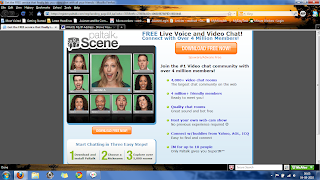
In early instant messaging programs each character appeared when it was typed. The UNIX "talk" command shown in this screenshot was popular in the 1980s and early 1990s.
Instant messaging predates the Internet, first appearing on multi-user operating systems like CTSS and Multics[2] in the mid-1960s. Initially, some of these systems were used as notification systems for services like printing, but quickly were used to facilitate communication with other users logged in to the same machine.[citation needed] As networks developed, the protocols spread with the networks. Some of these used a peer-to-peer protocol (e.g. talk, ntalk and ytalk), while others required peers to connect to a server (see talker and IRC). During the Bulletin board system (BBS) phenomenon that peaked during the 1980s, some systems incorporated chat features which were similar to instant messaging; Freelancin' Roundtable was one prime example.
In the last half of the 1980s and into the early 1990s, the Quantum Link online service for Commodore 64 computers offered user-to-user messages between currently connected customers which they called "On-Line Messages" (or OLM for short). (Quantum Link later became America Online and made AOL Instant Messenger (AIM), discussed later). While the Quantum Link service ran on a Commodore 64, using only the Commodore's PETSCII text-graphics, the screen was visually divided up into sections and OLMs would appear as a yellow bar saying "Message From:" and the name of the sender along with the message across the top of whatever the user was already doing, and presented a list of options for responding.[3] As such, it could be considered a sort of GUI, albeit much more primitive than the later Unix, Windows and Macintosh based GUI IM programs. OLMs were what Q-Link called "Plus Services" meaning they charged an extra per-minute fee on top of the monthly Q-Link access costs.
Modern, Internet-wide, GUI-based messaging clients as they are known today, began to take off in the mid 1990s with PowWow, ICQ, and AOL Instant Messenger. Similar functionality was offered by CU-SeeMe in 1992; though primarily an audio/video chat link, users could also type messages to each other. AOL later acquired Mirabilis, the creators of ICQ; a few years later ICQ (now owned by AOL) was awarded two patents for instant messaging by the U.S. patent office. Meanwhile, other companies developed their own applications (Excite, MSN, Ubique, and Yahoo), each with its own proprietary protocol and client; users therefore had to run multiple client applications if they wished to use more than one of these networks. In 1998 IBM released IBM Lotus Sametime, a product based on technology acquired when IBM bought Haifa-based Ubique and Lexington-based Databeam.
In 2000, an open source application and open standards-based protocol called Jabber was launched. The protocol was standardized under the name Extensible Messaging and Presence Protocol" (XMPP). XMPP servers could act as gateways to other IM protocols, reducing the need to run multiple clients. Multi-protocol clients can use any of the popular IM protocols by using additional local libraries for each protocol. IBM Lotus Sametime's November 2007 release added IBM Lotus Sametime Gateway support for XMPP.
In the current era, social networking providers often offer IM capabilities.
Many instant messaging services offer video calling features, Voice Over IP (VoIP) and web conferencing services. Web conferencing services can integrate both video calling and instant messaging capabilities. Some instant messaging companies are also offering desktop sharing, IP radio, and IPTV to the voice and video features.
The term "Instant Messenger" is a service mark of Time Warner[4] and may not be used in software not affiliated with AOL in the United States. For this reason, the instant messaging client formerly known as Gaim or gaim announced in April 2007 that they would be renamed "Pidgin".[5]
Read more...
 No Webcam is required to see people. Plus, you can share photos, files, and messages instantly with any Paltalk user. If you want to chat without the video and voice features, you can always instant message and use Paltalk for real-time text chat. New smileys, video overlays, and the 'nudge' are only a few of program's great features.
No Webcam is required to see people. Plus, you can share photos, files, and messages instantly with any Paltalk user. If you want to chat without the video and voice features, you can always instant message and use Paltalk for real-time text chat. New smileys, video overlays, and the 'nudge' are only a few of program's great features.


